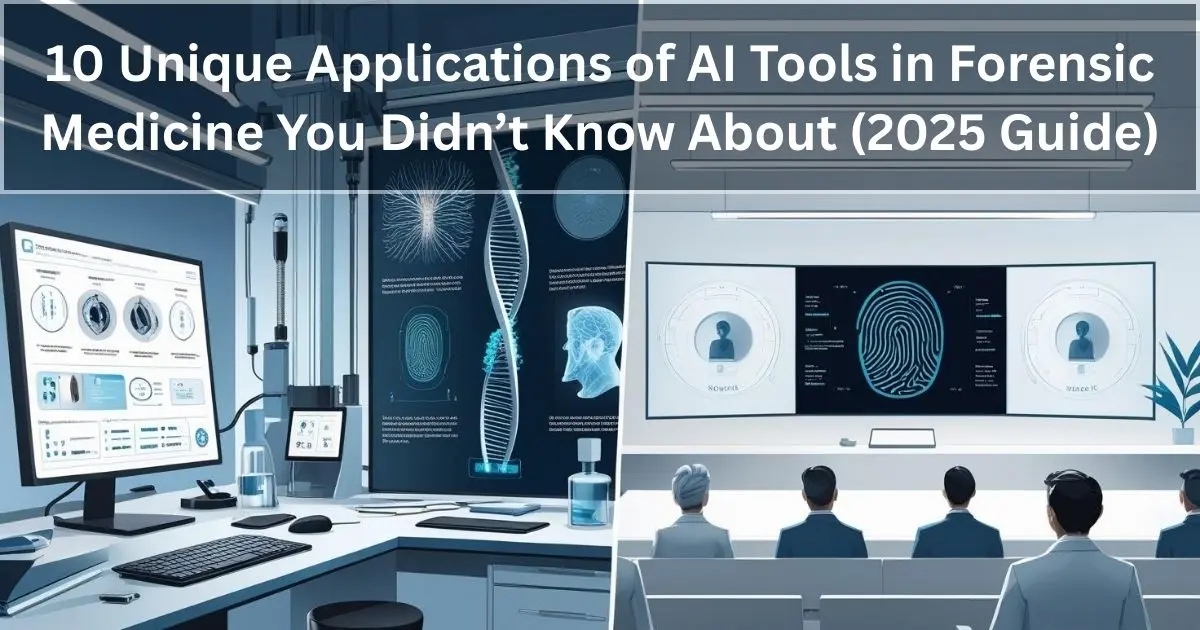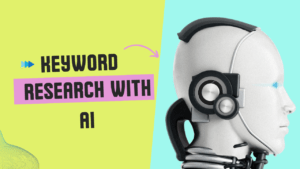Why AI Tools Are Revolutionizing Forensic Medicine
When most people hear about AI tools, they instantly think about business automation, chatbots like ChatGPT, or maybe even healthcare robots. But here’s the truth—AI tools in forensic medicine are creating unique applications that are quietly transforming the way crimes are solved. This isn’t science fiction anymore; it’s happening right now, and it’s way more advanced than most of us imagine.
Forensic experts used to rely heavily on manual observation, years of experience, and sometimes just a hunch. But today, AI in forensic science is cutting down the time it takes to process evidence, reducing human error, and giving investigators insights that were once impossible. Imagine solving crimes not in weeks or months but sometimes within hours—that’s the real power of AI for criminal justice.
And here’s the best part: this technology isn’t just about speed. It’s about accuracy, smarter data analysis, and creating stronger evidence in courtrooms. As we step into 2025, the future of forensic medicine looks like a perfect blend of human intelligence and machine precision. You’ll be surprised how AI can now help solve crimes faster, smarter, and with more accuracy than ever before.
1. Crime Scene Analysis with AI Tools
Now let’s get into one of the most fascinating AI tools forensic medicine unique applications—crime scene analysis. Traditionally, crime scene reconstruction required hours of photographing, sketching, and collecting samples by hand. Investigators would carefully measure blood spatter angles, footprint sizes, and weapon impact points. Sounds exhausting, right? And even then, there was room for human error.
That’s where AI in forensic crime scene analysis changes the game. With advanced image recognition systems, AI can scan blood patterns, fingerprints, and even footprints in seconds—something that would take a human expert much longer. These systems don’t just recognize evidence; they analyze it for patterns that might be invisible to the human eye.
For example, AI tools for crime scene reconstruction use drones equipped with high-resolution cameras. These drones, combined with AI-powered software, create 3D models of crime scenes within minutes. This means investigators can “walk through” the scene virtually, replay scenarios, and even test different possibilities of how the crime might have happened.
| Task | Traditional Method | With AI Tools |
|---|---|---|
| Blood spatter analysis | Hours of manual angle measurement | Seconds with AI image recognition |
| Footprint matching | Done manually, prone to errors | Automated, cross-checked with databases |
| Crime scene reconstruction | Sketches & photos (incomplete) | 3D virtual models with drones + AI |
What makes this so powerful is that AI doesn’t forget or overlook details. It captures every possible angle and creates a permanent digital record that investigators can revisit anytime. This is not only useful during investigation but also becomes powerful evidence in court when juries need to “see” what really happened.
For deeper insights into AI-assisted imaging, refer to research in Forensic Science International, which showcases breakthroughs in forensic imaging technologies
2. Digital Autopsies and Virtual Forensics
Most people still believe that solving the causes of death always requires a traditional autopsy — opening the body and examining organs. But that’s not always the case anymore. Thanks to AI tools in forensic medicine, experts now use something called a digital autopsy or virtual postmortem. And trust me, it’s changing the way forensic science works forever.
Instead of physically cutting into the body, forensic experts now rely on advanced imaging technologies like CT scans, MRI scans, and 3D body mapping. When these images are processed through AI-powered forensic software, they reveal hidden injuries, internal bleeding, or even poisoning patterns that the human eye could easily miss.
This is where the AI in digital autopsy forensic medicine becomes a real game-changer. Algorithms can scan through thousands of medical images in seconds, highlight suspicious areas, and even compare them with past forensic data. That means less human error, faster results, and highly accurate forensic reports that can stand strong in court.
Another big advantage? Cultural sensitivity. In many regions, families may refuse invasive autopsies due to religious or cultural reasons. Here, AI-powered virtual postmortem tools step in as a respectful, non-invasive alternative. The body remains untouched, yet investigators can still uncover the cause of death with scientific accuracy.
To give you a clearer picture, here’s how a Digital Autopsy with AI stacks up against the traditional one:
| Method | Traditional Autopsy | Digital Autopsy with AI |
|---|---|---|
| Approach | Physical dissection | Imaging (CT, MRI, 3D scans) |
| Speed | Hours to days | Minutes to hours |
| Accuracy | Depends on expert skill | Enhanced with AI analysis |
| Cultural Acceptance | Sometimes restricted | Non-invasive and widely accepted |
| Data Storage | Limited documentation | Digital, easily stored & shared |
Pretty impressive, right? Imagine how much time, money, and even emotional stress can be saved through these methods. And when combined with other AI-driven forensic tools, investigators now have a more holistic, error-free, and ethical approach to solving death-related cases.
When discussing digital autopsies, take a look at Virtual Autopsy UK or check PubMed for studies on AI-enabled virtual autopsy tools
3. DNA Profiling and Genetic Analysis
If there’s one area in forensic medicine where AI has shown jaw-dropping results, it’s DNA profiling. Traditionally, analyzing DNA was a long and complicated process — samples had to be carefully preserved, processed in labs, and compared manually. But with the arrival of AI tools for DNA profiling in forensic medicine, things have taken a massive leap forward.
AI algorithms can now analyze DNA sequences in a fraction of the time, running through thousands of genetic markers that would normally take experts days or weeks to decode. This not only makes the process faster but also reduces the risk of human errors that can compromise a criminal case.
A big challenge in forensic science has always been degraded DNA samples — for example, when evidence is exposed to heat, moisture, or simply too old to analyze properly. This is where AI for forensic DNA sequencing is making breakthroughs. Machine learning models can reconstruct missing genetic patterns, filter out noise from damaged samples, and still produce highly reliable matches.
Real-world example: Law enforcement agencies in Europe have successfully used AI-based DNA analysis to identify suspects from decades-old cold cases where traditional methods had failed. These tools can even predict certain physical traits (like eye or hair color) from DNA fragments, giving investigators a potential description of the suspect even without eyewitnesses.
The benefits of AI-powered DNA profiling go beyond just solving crimes. It helps in:
- Exonerating innocent people wrongly accused by providing clearer and more precise genetic evidence.
- Building faster suspect databases that speed up criminal investigations.
- Bringing closure to families in long-unsolved cases by finally identifying victims.
Imagine this: instead of waiting weeks for DNA results, AI could provide accurate insights within hours, completely transforming the way justice is served.
The NIJ’s ongoing research portfolio includes AI-powered DNA analysis and forensic case support, as detailed in their official work.
4. AI in Fingerprint and Biometric Matching
When we think of forensic investigations, the fingerprint often comes to mind as the classic “silent witness.” But today, with massive digital databases and millions of prints to compare, traditional manual matching is no longer enough. This is where AI biometric tools in forensic medicine are transforming the game.
AI systems can scan, analyze, and match fingerprints at lightning speed, even when the print is partial, smudged, or distorted. Advanced AI fingerprint analysis forensic tools can detect subtle ridge patterns and unique identifiers that the human eye may miss, drastically improving accuracy. This has made it possible to solve cases that were previously “unsolvable” because of poor-quality fingerprints.
Beyond fingerprints, AI has extended its reach into biometric recognition:
- Facial recognition technology: AI algorithms can match surveillance footage with criminal databases, even when faces are partially covered or captured in low light.
- Iris and retinal scans: These are among the most unique human identifiers, and AI-powered systems are now being tested for use in high-security forensic investigations.
Real-world impact: Some law enforcement agencies are already integrating multimodal biometric AI tools — combining fingerprints, facial recognition, and iris scans — to build more robust identification systems. This reduces false positives, increases reliability, and helps track suspects across different regions and databases.
The benefits are huge:
- Speed: Thousands of matches can be cross-checked in seconds.
- Accuracy: Fewer errors compared to human-only analysis.
- Scalability: Can handle massive global databases, making international investigations easier.
Imagine a scenario: a suspect leaves behind just a faint fingerprint on glass, while a CCTV captures only part of their face. Traditionally, this would be weak evidence. But with AI-powered biometric analysis, both pieces can be matched across databases, giving investigators a much stronger lead.
Interpol’s Biometric Hub uses advanced fingerprint and facial recognition algorithms connected to its AFIS system—an example of a real-world AI application
5. Predictive Analytics in Criminal Behavior
One of the most groundbreaking applications of AI in forensic medicine is the use of predictive analytics to understand and even anticipate criminal behavior. By analyzing huge amounts of data — from social media interactions and online searches to past criminal records and environmental triggers — AI systems can spot patterns of risk that may escape human observation.
Modern AI predictive tools for forensic psychology allow investigators to assess a suspect’s psychological profile, identify stress indicators, and even predict possible relapse into criminal activity. This branch of AI in criminal profiling forensic science is increasingly being used to support both crime prevention and ongoing investigations.
For example, in cybercrime investigations, AI can detect unusual online activities — such as large-scale phishing attempts, sudden spikes in dark web transactions, or coded communications — that suggest a coordinated criminal operation. In physical crime contexts, AI may analyze location data, previous offenses, and behavioral cues to identify potential suspects or hotspots where crimes are more likely to occur.
Real-world impact: Law enforcement agencies have begun using AI-powered analytics to monitor cyber threats, track criminal networks, and even support rehabilitation programs by identifying individuals at higher risk of reoffending.
The benefits are significant:
- Prevention: Authorities can act before a crime escalates.
- Profiling accuracy: AI provides deeper insights into psychological and behavioral factors.
- Resource optimization: Helps law enforcement prioritize high-risk cases.
However, ethical considerations remain vital. While predictive AI can reduce crime, it also raises concerns about privacy, bias, and the possibility of mislabeling innocent individuals. For this reason, experts emphasize that these tools must be used as supportive aids, not as the sole basis for decisions.
6. Voice and Audio Forensics with AI
With the rise of advanced communication technologies, criminals often leave behind audio footprints — whether through phone calls, video messages, or even voice notes on encrypted platforms. This is where AI voice analysis forensic applications are proving to be game-changers.
AI can analyze a person’s voice by looking at pitch, tone, speech rhythm, and micro-tremors that humans can’t easily detect. These subtle markers help in verifying identity and distinguishing between real speech and manipulated audio. This makes AI speech recognition in forensic medicine a valuable tool in modern investigations.
One of the most pressing challenges today is the threat of deepfakes and voice manipulations. AI-powered forensic tools can detect anomalies in wave patterns and background frequencies that reveal whether a recording has been tampered with. This not only strengthens evidence in court but also protects against wrongful accusations.
Case use example: In several cyber fraud cases, investigators have used AI to compare criminal call recordings with existing voice databases, successfully identifying suspects who tried to mask their voices. Similarly, AI tools have been applied in counter-terrorism efforts to authenticate anonymous calls and link them to known criminals.
Key advantages include:
- Lie detection: AI picks up stress markers and inconsistencies in speech.
- Forgery detection: Identifies doctored audio and deepfake content.
- Identification: Matches suspect voices with recordings across huge databases.
MIT Media Lab’s deepfake detection research offers great guidance on audio and video authentication methods
7. Cyber Forensics Powered by AI
In today’s digital-first world, most crimes leave behind virtual footprints — from hacked accounts and ransomware attacks to online financial fraud. Traditional digital investigation methods often struggle to keep up with the speed and complexity of cybercrime. This is where AI in cyber forensic investigations has become a powerful ally.
AI systems can analyze massive volumes of digital data in seconds, spotting unusual patterns of hacking attempts, phishing trails, or insider threats that humans might overlook. With AI-powered digital forensic tools, investigators can recover deleted files, trace IP addresses, and even reconstruct fragmented data hidden deep inside hard drives or cloud systems.
What makes AI invaluable in this field is its ability to learn and adapt. Algorithms continuously evolve by studying new cyberattack methods, which helps predict and prevent future breaches. Forensic experts now rely on AI to link complex digital footprints together, identifying not only the attack but also the network of people behind it.
Real-world example: Financial institutions use AI-driven cyber forensics to monitor millions of transactions daily. When suspicious activities such as money laundering or fraudulent transfers occur, AI algorithms immediately flag them, allowing investigators to track fraud and financial crimes with unmatched precision.
Key advantages of AI in cyber forensics include:
- Pattern detection: Identifying hacking signatures and malware traces.
- Data recovery: Retrieving deleted or hidden digital evidence.
- Behavior tracking: Monitoring unusual online activity and linking it to suspects.
Europol’s reports on AI-powered cybercrime monitoring provide valuable insight into how artificial intelligence is changing digital crime investigations
8. Toxicology and Drug Detection with AI
Forensic toxicology plays a critical role in solving cases involving drug overdoses, poisonings, and substance-related crimes. Traditionally, toxicology tests are time-consuming, requiring multiple lab processes to identify an unknown substance. But with the rise of AI toxicology tools in forensic medicine, this process has become faster, smarter, and far more accurate.
AI can analyze chemical signatures within blood, urine, or tissue samples, comparing them against vast drug and poison databases in seconds. What makes this even more powerful is AI’s ability to recognize new patterns and flag substances that don’t match known categories. This feature is crucial in detecting new synthetic drugs or designer poisons that criminals often use to escape traditional screening methods.
With AI in forensic drug analysis, laboratories can now detect ultra-small traces of chemicals, even in degraded or mixed samples. This not only speeds up investigations but also helps deliver concrete evidence in court cases, strengthening justice outcomes.
Real-world case example: In recent years, AI-driven toxicology systems have been used to identify novel synthetic opioids involved in sudden death cases. By cross-referencing vast pharmaceutical and chemical libraries, AI flagged these compounds within hours — a process that would otherwise take weeks with traditional methods.
Key benefits of AI in toxicology labs include:
- Rapid detection: Faster identification of unknown or hidden drugs.
- Higher accuracy: Reduced risk of false negatives in screenings.
- Predictive alerts: Spotting new chemical structures likely to be abused as drugs.
The NIDA continues to explore AI’s role in understanding substance use and forensic toxicology via their data science research initiatives.
9. Image and Video Analysis for Evidence Validation
In today’s digital world, criminals are not only committing crimes but also trying to manipulate evidence through photo editing, video tampering, or even creating deepfakes. For forensic experts, distinguishing between real and altered media can be extremely challenging. This is where AI tools for forensic video analysis step in as a game-changer.
AI systems use advanced algorithms to detect inconsistencies in pixels, shadows, reflections, and compression artifacts that the human eye might easily miss. Whether it’s a manipulated surveillance video, a doctored photograph, or fake social media content, AI can validate digital evidence with high accuracy.
With AI image forensics in criminal investigations, investigators can now trace back the editing history of media files, authenticate timestamps, and confirm whether a piece of evidence has been digitally altered. This is crucial for ensuring that courts only rely on genuine, untampered material when making judgments.
Use case example: In several cybercrime cases, AI has successfully identified deepfake videos that were created to mislead investigators or frame innocent people. By analyzing micro-expressions and unnatural frame transitions, AI flagged these fakes, ensuring justice was not derailed.
Key strengths of AI in image & video forensics include:
- Deepfake detection: Identifying AI-generated fake videos and voices.
- Evidence authentication: Validating whether photos or videos have been altered.
- Speed & accuracy: Processing large volumes of surveillance footage quickly.
DARPA’s SemaFor and MediFor programs aim to detect and explain digital manipulations using innovative AI methods.
10. AI in Courtroom and Legal Forensics
The role of AI is not limited to laboratories and investigations—it has also entered the courtroom, transforming the way justice is delivered. Managing large volumes of case files, digital evidence, and expert reports can overwhelm both lawyers and judges. This is where AI tools in forensic legal applications provide a much-needed advantage.
AI can automatically organize, categorize, and summarize evidence, making it easier for legal teams to build strong cases. Instead of sifting through thousands of pages, lawyers can rely on AI-powered systems to highlight the most relevant details—from forensic reports to witness statements. This ensures faster case preparation and reduces human error.
In addition, AI in courtroom forensic decision-making assists judges and juries by presenting evidence in a clear, structured, and unbiased way. For example, AI can generate timelines of events, identify contradictions in testimonies, and even simulate how digital evidence connects to the crime scene.
Use case example:
In complex fraud trials, AI has been used to summarize financial transactions and provide simplified visual reports. This helped the jury understand otherwise confusing data and prevented manipulation of evidence by either party.
Key contributions of AI in courtroom forensics:
- Evidence management: Organizing forensic reports, case files, and digital exhibits.
- Summarization tools: Condensing complex forensic data for easy understanding.
- Unbiased presentation: Helping judges and juries focus on facts, not clutter.
Challenges & Ethical Concerns of AI in Forensics
While AI brings incredible advancements to forensic medicine, it also raises some serious ethical questions. After all, when decisions involve life-or-death legal cases, can we fully rely on machines to deliver the truth?
One of the biggest issues is bias. AI tools are only as good as the data they are trained on. If the training data carries hidden biases (e.g., racial, gender, or cultural), then the system’s results may unintentionally favor or discriminate against certain groups. This could lead to unfair judgments in criminal investigations.
Another challenge is privacy. Forensic AI tools often require access to sensitive data such as DNA, medical records, or personal digital information. Without strict security protocols, there’s a risk of data misuse or leaks, which can harm victims, suspects, and even innocent citizens.
A third concern is over-reliance on AI. While AI forensic tools are powerful, they are not perfect. If investigators or judges depend too much on these systems, there’s a danger that human judgment and professional expertise may be overshadowed. Forensic experts should view AI as a supporting tool—not the ultimate decision-maker.
Engagement Question: Should we fully trust AI in life-or-death legal cases, or should it always remain just an assistant to human experts?
Key ethical challenges of AI in forensic medicine:
- Bias in algorithms: Risk of unfair judgments.
- Privacy concerns: Misuse of sensitive forensic and medical data.
- Over-reliance: Human expertise must remain central in investigations.
Future of AI Tools in Forensic Medicine
As we step into 2025 and beyond, AI in forensic medicine is expected to grow from being a “support tool” into becoming a strategic partner for investigators, doctors, and legal teams. The future of AI in forensic medicine unique applications lies in combining speed, accuracy, and innovation with human expertise.
We may soon see AI trends in forensic science 2025 such as:
- Real-time DNA profiling: AI could reduce the time it takes to process DNA samples from days to just a few hours.
- Predictive toxicology: Instead of waiting for lab reports, AI could forecast the effects of unknown substances by comparing them with global chemical databases.
- Advanced video forensics: Next-generation AI will likely detect even the most sophisticated deepfakes, helping courts validate evidence with greater confidence.
- Cross-border forensic intelligence: AI tools may allow international law enforcement agencies to collaborate instantly, sharing data on cybercrimes, trafficking, or terrorism.
But here’s the most important part: AI should be seen as a partner, not a replacement. Forensic medicine is as much about human intuition, empathy, and judgment as it is about data and machines. AI can enhance accuracy and efficiency, but the final responsibility must always rest with human experts who understand the broader context of justice and ethics.
Takeaway for readers: The future of AI in forensics is not about replacing investigators, but about empowering them to solve cases faster and more fairly.
Conclusion: AI Is Changing the Game in Forensic Medicine
Artificial intelligence is no longer just a futuristic concept—it’s already transforming forensic medicine in powerful ways. From AI toxicology tools in forensic medicine that detect hidden poisons, to AI tools for forensic video analysis that catch deepfakes, the applications are as diverse as they are impactful.
Let’s quickly recap the 10 unique applications of AI in forensic medicine we explored:
- AI in forensic pathology for faster autopsies
- Predictive models for determining time of death
- AI-powered facial recognition in investigations
- Voice and speech analysis for suspect identification
- DNA profiling with machine learning algorithms
- AI in cyber forensics for digital crimes
- Emotion and behavior analysis in forensic psychology
- AI-enhanced crime scene reconstruction
- Toxicology and drug detection with AI
- Image and video analysis for evidence validation
We also looked at how AI is supporting courtroom and legal forensics, the ethical challenges, and the future trends of AI in forensic science by 2025. Together, these advances show us that AI is not replacing forensic experts—it’s amplifying their skills and providing them with sharper, faster, and more reliable tools.
Final takeaway: AI in forensic medicine has unique applications that are rewriting the rules of criminal investigations, helping ensure justice is served with greater accuracy and speed.
FAQs About AI Tools in Forensic Medicine
Q1. What is the role of AI in forensic medicine?
AI helps forensic experts analyze evidence faster and more accurately. It supports DNA profiling, toxicology, cyber forensics, crime scene reconstruction, and even courtroom case management.
Q2. How are AI tools used in forensic toxicology?
AI toxicology tools in forensic medicine can identify unknown drugs, poisons, and synthetic chemicals much faster than traditional lab methods, making it easier to solve complex cases.
Q3. Can AI detect deepfake videos or tampered images?
Yes. AI tools for forensic video analysis and image forensics are highly effective at spotting digital manipulation, such as deepfakes, altered photos, or fake recordings.
Q4. Is AI replacing forensic experts?
No. AI is not a replacement but a partner. While it automates repetitive tasks and speeds up investigations, human expertise is still critical for decision-making and courtroom validation.
Q5. What are the ethical issues of AI in forensic science?
Some challenges include algorithm bias, privacy concerns, and the danger of over-reliance on AI in life-or-death legal cases. That’s why human oversight remains essential.
Q6. What is the future of AI in forensic medicine?
By 2025 and beyond, AI trends in forensic science include smarter predictive models, more accurate drug detection, improved behavioral analysis, and AI-powered legal forensics.
Q7. How does AI help in cyber forensic investigations?
AI in cyber forensic investigations helps track digital footprints, detect hacking patterns, and recover deleted files—making it easier to fight cybercrime and financial fraud.





Your writing has a way of making even the most complex topics accessible and engaging. I’m constantly impressed by your ability to distill complicated concepts into easy-to-understand language.
Your writing is a true testament to your expertise and dedication to your craft. I’m continually impressed by the depth of your knowledge and the clarity of your explanations. Keep up the phenomenal work!
I do trust all the ideas youve presented in your post They are really convincing and will definitely work Nonetheless the posts are too short for newbies May just you please lengthen them a bit from next time Thank you for the post
Your writing has a way of resonating with me on a deep level. I appreciate the honesty and authenticity you bring to every post. Thank you for sharing your journey with us.
Your ability to distill complex concepts into digestible nuggets of wisdom is truly remarkable. I always come away from your blog feeling enlightened and inspired. Keep up the phenomenal work!